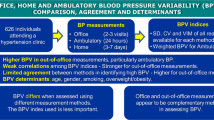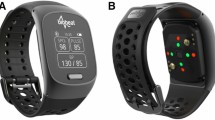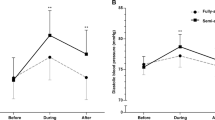Abstract
The aim of this study was to determine concordance between physician and patient blood pressure (BP) measurements in an ambulatory setting. A diagnostic intervention cross-sectional study using a convenience sample was employed. A total of 106 hypertensive patients were included in the study. Patients who were unable to perform their self-measurement or those with cardiac arrhythmia were excluded. BP was determined nine times in each subject in the medical office in a randomised order: BP was taken three times by the physician using a mercury sphygmomanometer (SPH-Hg), three times by the physician using a validated, automated oscillometer (Omron HEM 705 CP), and three times by the patient himself with the same device. The intraclass correlation coefficient was calculated. In all, 59 women and 47 men aged 65.7 (10) years were analysed. Mean BP measurements for the physician using the mercury sphygmomanometer, the physician using the Omron, and the patient using the same device were: 136 (15.8)/80 (11), 137 (17.9)/80 (10), and 139* (17.6)/80 (10) mmHg, respectively. BP control was 48.1, 48.1, and 36.8*% (*P<0.05), respectively. Intraclass correlation coefficients for systolic/diastolic pressures were: 0.77/0.65 (physician—sphygmomanometer Hg, physician—Omron; P<0.001), 0.75/0.64 (physician—sphygmomanometer Hg, patient—Omron, P<0.001), and 0.83/0.83 (physician—Omron, patient—Omron; P<0.001). In conclusion, the three types of measurement in the medical office were significantly concordant. Patient office self-measurement showed a tendency to increase systolic BP and worsen BP control.
This is a preview of subscription content, access via your institution
Access options
Subscribe to this journal
Receive 12 digital issues and online access to articles
$119.00 per year
only $9.92 per issue
Buy this article
- Purchase on Springer Link
- Instant access to full article PDF
Prices may be subject to local taxes which are calculated during checkout

Similar content being viewed by others
References
WHO. International Society of Hypertension. Guidelines for the Management of Hypertension, WHO 1999.
Beevers G, Lip GYH, O’Brien E . Blood pressure measurement. Sphygmomanometry: factors common to all techniques. BMJ 2001; 322: 981–985.
Beevers G, Lip GYH, O'Brien E . Conventional sphygmo-manometry: technique of auscultatory blood pressure measurement. BMJ 2001; 322: 1043–1047.
McKay DW et al. Clinical assessment of blood pressure. J Hum Hypertens 1990; 4: 639–645.
McAlister FA, Straus SE . Measurement of blood pressure: an evidence based review. BMJ 2001; 322: 908–911.
Rasmussen SL, Torp-Pedersen C, Borch-Johnsen K, Ibsen H . Normal values for ambulatory blood pressure and differences between casual blood pressure and ambulatory blood pressure: results from a Danish population survey. J Hypertens 1998; 16: 1415–1424.
Mancia G et al. Ambulatory blood pressure normality: results from the PAMELA study. J Hypertens 1995; 13: 1377–1390.
Ohkubo T et al. Reference values for 24-hour ambulatory blood pressure monitoring based on a prognostic criterion: Ohasama study. Hypertension 1998; 32: 255–259.
Staessen JA, Thijs L . Development of diagnostic thresholds for automated self-measurement of blood pressure in adults. First International Consensus Conference on Blood Pressure Self-Measurement. Blood Press Monit 2000; 5: 101–109.
Weisser B et al. Normal values of blood pressure self-measurement in view of the 1999 World Health Organization—International Society of Hypertension Guidelines. Am J Hypertens 2000; 13: 940–943.
Garcia-Vera MP, Labrador FJ, Sanz J . Comparison of clinic, home self-measured, and work self-measured blood pressures. Behav Med 1999; 25: 13–22.
La Batide-Alanore A et al. Comparison of nurse- and physician-determined clinic blood pressure levels in patients referred to a hypertension clinic: implications for subsequent management. J Hypertens 2000; 18: 391–398.
O'Neill H, O'Brien E, Stanton A, Heddictch K . The suitability of an automated blood pressure measuring device—the Omron HEM-705CP—in a large multicentre study: the ASCOT study. J Hum Hypertens 2001; 15(Suppl 1): S83-S85
Bland JM, Altman DG . Statistical methods for assessing agreement between two methods of clinical measurement. Lancet 1986; 1: 307–310.
Association for the Advancement of Medical Instrumentation American National Standard for Electronic or Automated Sphingmomanometers, AAMI: Arlington 1987.
The Sixth Report of the Joint National Committee on Prevention, Detection, Evaluation and Treatment of High Blood Pressure. Arch Intern Med 1997; 157: 2413–2446.
Deyo RA, Diehr P, Patrick DL . Reproducibility and responsiveness of health status measures. Statistics and strategies for evaluation. Control Clin Trials 1991; 12(4 Suppl): 142–158.
Mengden T et al. User procedure for self-measurement of blood pressure. First International Consensus Conference on Self Blood Pressure Measurement. Blood Press Monit 2000; 5: 111–129.
Myers MG, Meglis G, Polemidiotis G . The impact of physician vs automated blood pressure readings on office-induced hypertension. J Hum Hypertens 1997; 11: 491–493.
Council Directive of 22 December 1979 on the approximation of the laws of the Member States relating to units of measurement and on the repeal of Directive 71/354/ECC Official Journal of the European Communities, No. L 39. 15.2 1980., p42.
O’Brien E . Replacing the mercury sphygmomanometer. BMJ 2000; 320: 815–816.
Hozawa A et al. Prognosis of isolated systolic and isolated diastolic hypertension as assessed by self-measurement of blood pressure at home: the Ohasama study. Arch Intern Med 2000; 160: 3301–3306.
Ohkubo T et al. Home blood pressure measurement has a stronger predictive power for mortality than does screening blood pressure measurement: a population-based observation in Ohasama, Japan. J Hypertens 1998; 16: 971–975.
Tsuji I et al. Proposal of reference values for home blood pressure measurement. Prognostic criteria based on a prospective observation of the general population in Ohasama, Japan. Am J Hypertens 1997; 10: 409–418.
Acknowledgements
This study was supported by a grant from Fundació Jordi Gol i Gurina.
Author information
Authors and Affiliations
Corresponding author
Rights and permissions
About this article
Cite this article
Vinyoles, E., Blancafort, X., López-Quiñones, C. et al. Blood pressure measurement in an ambulatory setting: concordance between physician and patient self-measurement. J Hum Hypertens 17, 45–50 (2003). https://doi.org/10.1038/sj.jhh.1001505
Published:
Issue Date:
DOI: https://doi.org/10.1038/sj.jhh.1001505
Keywords
This article is cited by
-
Are Unattended Blood Pressure Measurements Necessary in All Patients Visiting an Outpatient Cardiology Clinic?
High Blood Pressure & Cardiovascular Prevention (2020)
-
Automated Office-Based Blood Pressure Measurement: an Overview and Guidance for Implementation in Primary Care
Current Hypertension Reports (2019)



